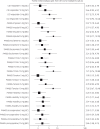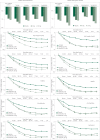Response to inhaled loxapine in patients with schizophrenia or bipolar I disorder: PANSS-EC responder analyses
- PMID: 29163985
- PMCID: PMC5680528
- DOI: 10.1192/bjpo.bp.117.005363
Response to inhaled loxapine in patients with schizophrenia or bipolar I disorder: PANSS-EC responder analyses
Abstract
Background: Efficacy of inhaled loxapine 5 or 10 mg in treating agitation was shown using the Positive and Negative Syndrome Scale - Excited Component (PANSS-EC) in two Phase III randomised, double-blind, placebo-controlled trials in 344 agitated patients with schizophrenia and 314 patients with bipolar I disorder (Clinicaltrials.gov: NCT00628589, NCT00721955).
Aims: To examine the five individual items comprising the PANSS-EC and the percentage of patients achieving a clinical response (reduction of ≥40%) in PANSS-EC (Response-40) for these two studies.
Method: Response-40 was examined at the primary end-point (2 h) and over time.
Results: Response-40 and each PANSS-EC item score were statistically significant v. placebo at 2 h and at each assessment time point for both doses.
Conclusions: Inhaled loxapine produced rapid improvement in agitated patients with schizophrenia or bipolar I disorder, achieving Response-40 at the first assessment (10 min post dose). These results highlight the effectiveness of loxapine across all components of agitation as measured by the PANSS-EC.
Declaration of interest: S.Z. is a member of the speakers bureau for Grupo Ferrer. L.Z. has been a speaker and grant recipient for Teva Pharmaceuticals. J.V.C. and D.A.S. were employees of Alexza Pharmaceuticals during execution of the studies, and are currently paid consultants for and have received stock and/or stock options from Alexza Pharmaceuticals. P.P.Y. is a full-time employee and receives stock options from Teva Pharmaceuticals.
Copyright and usage: © The Royal College of Psychiatrists 2017. This is an open access article distributed under the terms of the Creative Commons Non-Commercial, No Derivatives (CC BY-NC-ND) license.
Figures



Similar articles
-
Rapid acute treatment of agitation in individuals with schizophrenia: multicentre, randomised, placebo-controlled study of inhaled loxapine.Br J Psychiatry. 2011 Jan;198(1):51-8. doi: 10.1192/bjp.bp.110.081513. Br J Psychiatry. 2011. PMID: 21200077 Clinical Trial.
-
Rapid acute treatment of agitation in patients with bipolar I disorder: a multicenter, randomized, placebo-controlled clinical trial with inhaled loxapine.Bipolar Disord. 2012 Feb;14(1):31-40. doi: 10.1111/j.1399-5618.2011.00975.x. Bipolar Disord. 2012. PMID: 22329470 Clinical Trial.
-
Inhaled loxapine for agitation revisited: focus on effect sizes from 2 Phase III randomised controlled trials in persons with schizophrenia or bipolar disorder.Int J Clin Pract. 2012 Mar;66(3):318-25. doi: 10.1111/j.1742-1241.2011.02890.x. Epub 2012 Jan 9. Int J Clin Pract. 2012. PMID: 22226343 Review.
-
Efficacy and safety of loxapine for inhalation in the treatment of agitation in patients with schizophrenia: a randomized, double-blind, placebo-controlled trial.J Clin Psychiatry. 2011 Oct;72(10):1313-21. doi: 10.4088/JCP.10m06011yel. J Clin Psychiatry. 2011. PMID: 21294997 Clinical Trial.
-
Aerosolised antipsychotic assuages agitation: inhaled loxapine for agitation associated with schizophrenia or bipolar disorder.Int J Clin Pract. 2011 Mar;65(3):330-40. doi: 10.1111/j.1742-1241.2010.02615.x. Epub 2010 Dec 29. Int J Clin Pract. 2011. PMID: 21199198 Review.
Cited by
-
Disentangling the relationship between cholesterol, aggression, and impulsivity in severe mental disorders.Brain Behav. 2020 Sep;10(9):e01751. doi: 10.1002/brb3.1751. Epub 2020 Jul 17. Brain Behav. 2020. PMID: 32681586 Free PMC article.
-
Inhaled Loxapine for the Management of Acute Agitation in Bipolar Disorder and Schizophrenia: Expert Review and Commentary in an Era of Change.Drugs R D. 2019 Mar;19(1):15-25. doi: 10.1007/s40268-019-0262-3. Drugs R D. 2019. PMID: 30721526 Free PMC article. Review.
-
Examining the safety, efficacy, and patient acceptability of inhaled loxapine for the acute treatment of agitation associated with schizophrenia or bipolar I disorder in adults.Neuropsychiatr Dis Treat. 2019 Aug 7;15:2273-2283. doi: 10.2147/NDT.S173567. eCollection 2019. Neuropsychiatr Dis Treat. 2019. PMID: 31496709 Free PMC article. Review.
References
-
- American Psychiatric Association. Diagnostic and Statistical Manual of Mental Disorders, Fifth Edition (DSM-5). APA, 2013.
-
- Alderfer BS, Allen MH. Treatment of agitation in bipolar disorder across the life cycle. J Clin Psychiatry 2003; 64 (suppl 4): 3–9. - PubMed
-
- Hankin CS, Bronstone A, Koran LM. Agitation in the inpatient psychiatric setting: a review of clinical presentation, burden, and treatment. J Psychiatr Pract 2011; 17: 170–85. - PubMed
-
- Marder SR. A review of agitation in mental illness: treatment guidelines and current therapies. J Clin Psychiatry 2006; 67 (suppl 10): 13–21. - PubMed
-
- Nordstrom K, Allen MH. Alternative delivery systems for agents to treat acute agitation: progress to date. Drugs 2013; 73: 1783–92. - PubMed
Associated data
LinkOut - more resources
Full Text Sources
Other Literature Sources
Medical
Research Materials

